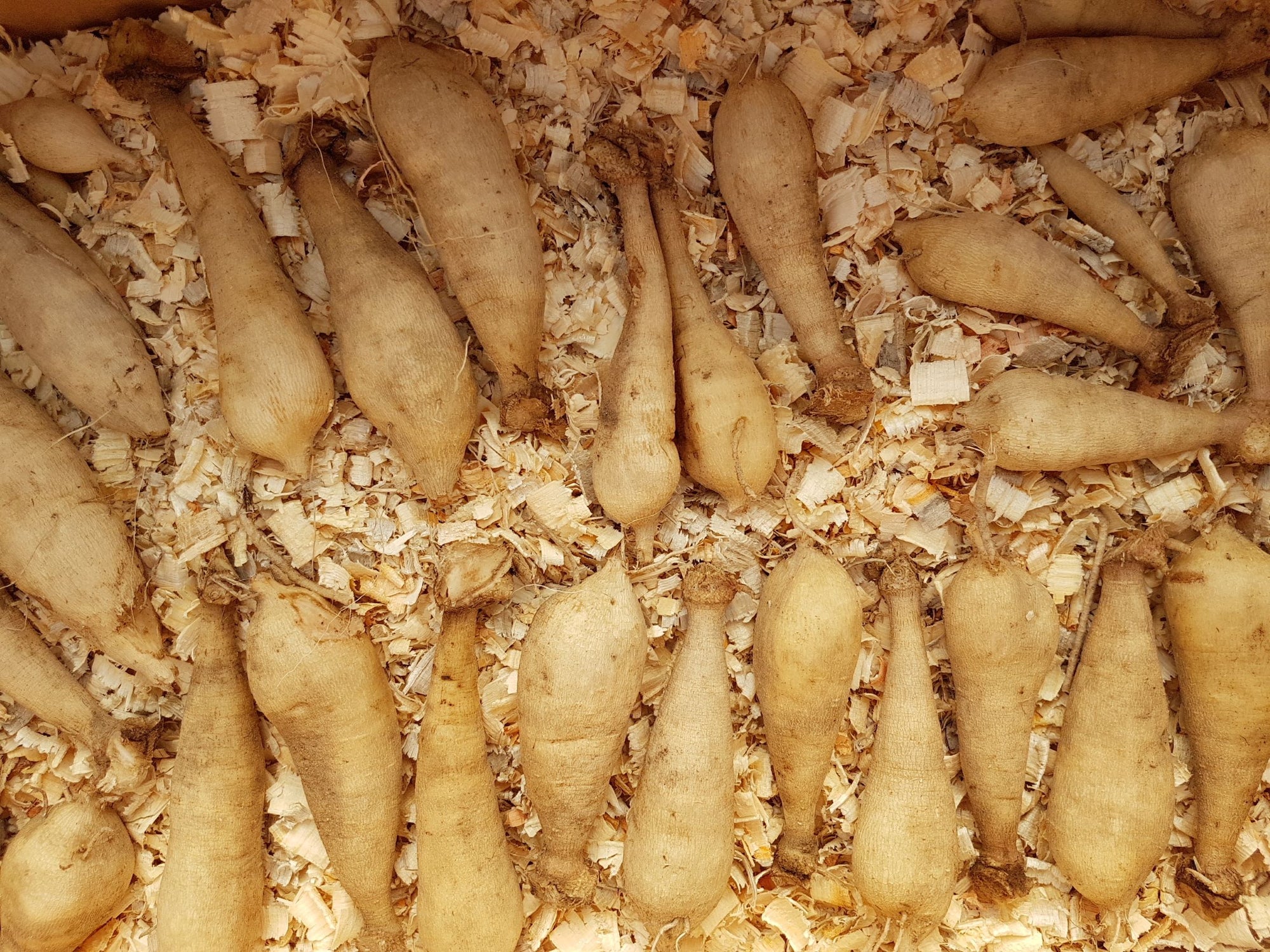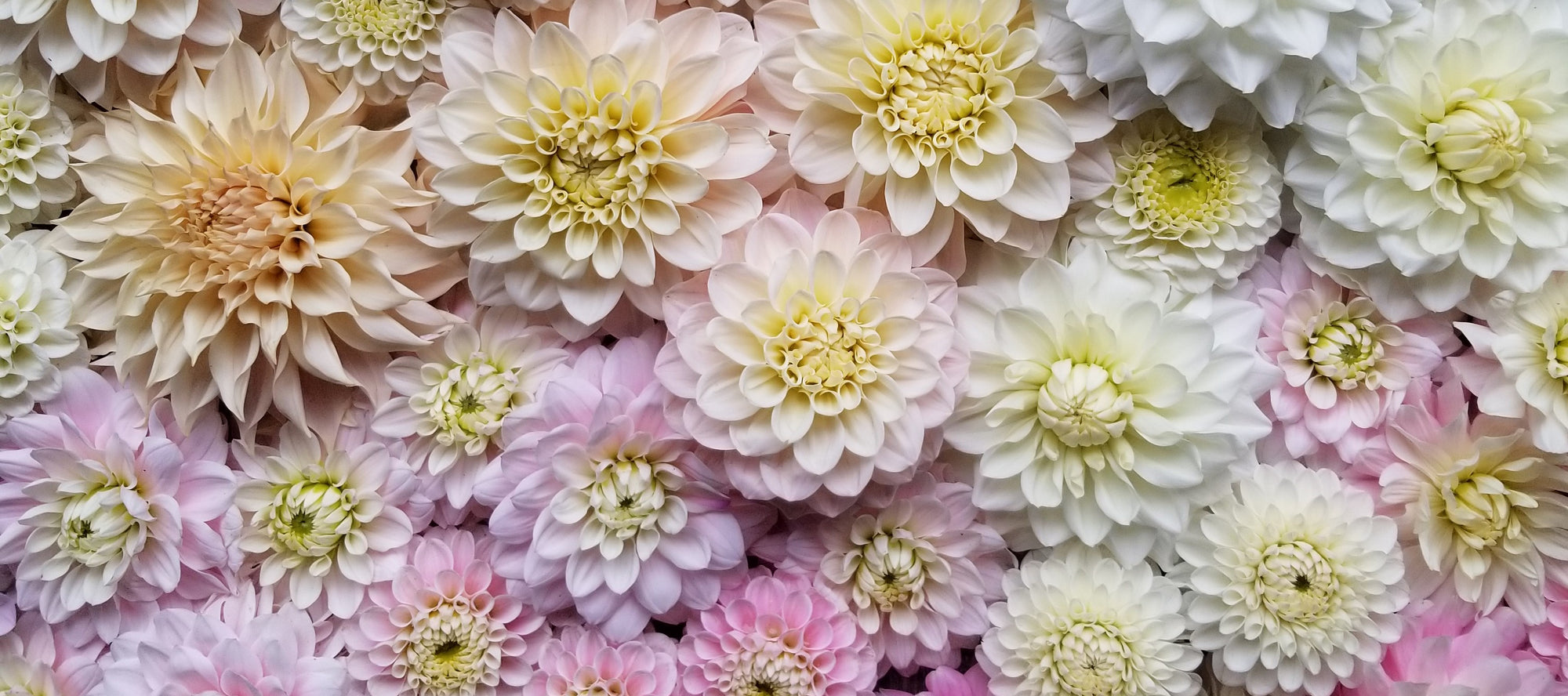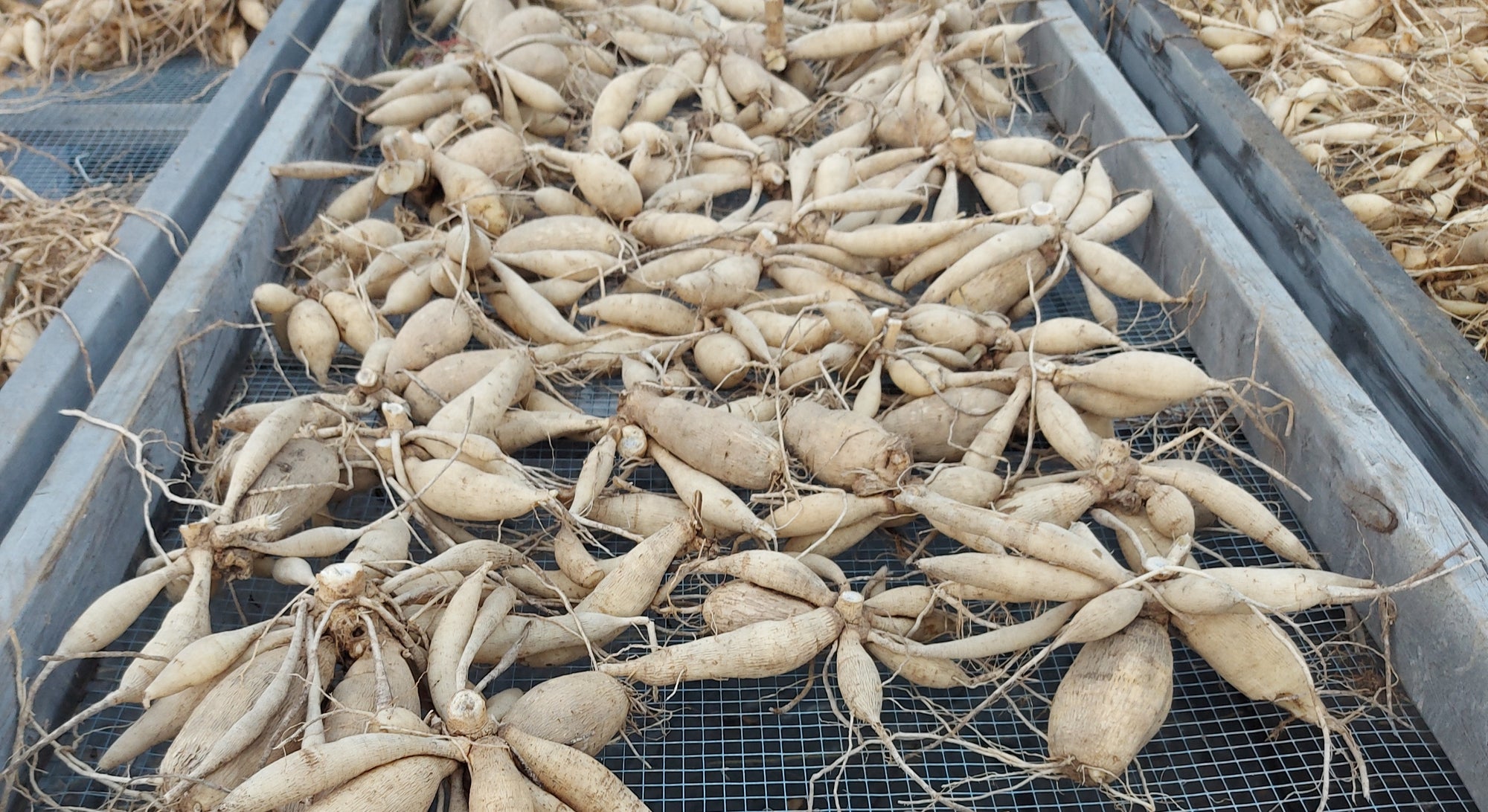Learn best practices for successfully storing your dahlias overwinter
Storing dahlias seems to be one of the biggest challenges for many gardeners and growers. But once you learn some of the basic requirements you can tailor a program that takes into consideration your specific climate and space.
There are as many storage methods as there are dahlia growers! I'll share our method with you that has worked for us successfully for years, but the most important thing is to build a program that works for you.
The Basics:
- They can't freeze! Ideal storage temperature is around 5 degrees C (40 F), or a range of 5-10 C (40-50F)
- You don't want them to rot or to dry out. You want high relative humidity, at least 70%
- Good storage media are vermiculite, peat moss, wood shavings (pet/ horse bedding), or a mix of peat and vermiculite (our preferred media). If using peat moss, just be sure your tubers are dry, and the peat isn't too moist. Peat can hold a lot of moisture and depending on conditions contribute to rot. But lots of folks pack their tubers in peat, so it just depends on your specific site! Also, wood shavings can sometimes pull moisture out of your tubers, so I recommend having them in sealed totes if you're using shavings. But I find that something is better than nothing, so use what you have!
- You can use any kind of container, crate, bins, boxes or bags. We use plastic storage totes with holes drilled in them because in our climate we are usually more concerned with tubers drying out.
- If you have perfect storage conditions, some people just store whole clumps loose in crates lined with paper.
Here's something I like to keep in mind when thinking about storing dahlia tubers: they're happiest tucked into the ground for winter. Unfortunately that's not an option for most of us, so I try to think how I can provide something that would be similar to that!
In the past we haven't had enough space to keep our tubers whole, so we usually divide them in late fall before putting them into storage.
After trying a variety of methods, storing our divided tubers in sealed Rubbermaid-type totes has given us the best results. It allows us to better control the moisture during storage. For smaller growers, I think the clear, plastic shoe-box type containers are the best! This way you can keep an eye on things without needing to open every box. If the moisture is too high you will see condensation on the inside of the container and then you can crack the lid for a day to let things dry out and then seal it back up. If you're keeping them whole, then storing them in a larger tote or even a plastic bag, covered in peat (or whatever you're using) would work fine! Then if you notice too much moisture, you can just crack the bag open to allow some air movement.

Generally, a basement is a great place to store your tubers. The temperature tends to be cool and consistent which makes storage easier. Remember that tubers can't freeze and a temperature 5-10C is preferred. Closer to 10 (50F) seems better, but much above 15C (60F) and your tubers will likely start growing again. Your specific climate and storage area will determine how you will want to store them. Winter air is usually cold and dry so most people have to watch for the tubers drying out. However, if your basement is more air-tight and tends to be damp, you'll want to be on alert for signs of rotting.
Choose a storage media. Coarse vermiculite, peat moss, or a mix of peat and vermiculite are all good options. Last year we used a mix ( about 3 to 1) of peat moss and vermiculite as our storage medium and were really happy with it. In the past we have also had great success with pure vermiculite and fairly good results from wood shavings as well. Depending on the humidity, wood chips can mold, so keep your eyes peeled for any signs of mold in the chips. We start by adding a couple inches of mix in the bottom and then laying tubers out across the bed of peat so they are not touching. (Keeping the tubers separated in storage can help prevent rot from spreading) We then add another layer of the peat/ vermiculite to cover and keep repeating the process until the tote is full. We put only one variety in each tote and label it carefully on the inside and out. You can use the same method with any type of medium you choose- just keep layering them in and covering them up. One thing to keep in mind is that if you have many deep layers, it is more difficult to check the tubers at the very bottom! As I mentioned before, the small shoe-box size clear tote is a great choice if you're storing divided tubers.

Remember the best type of container or storage media is the one that works for you! The main goal is to successfully bring your tubers through winter for planting next season.
You likely can't avoid having a few problems, but you can avoid total disaster by checking your tubers regularly throughout the winter. This way you can make any necessary adjustments before losing all your tubers.
Check your tubers regularly throughout winter
- We recommend checking them more frequently in early winter as this seems to be when there is more fluctuation in temperature and storage conditions which can cause heavier condensation or quicker drying. Then things usually seem to stabilize until the spring warm-up starts.
- How do they look? If you're using a paper bag and they seem to be drying out you could place them in plastic. If they're in plastic and drying out- do you have a snug fitting lid? Are they completely covered by storage media? If they're in plastic and your noticing a lot of dampness or condensation, you can open up the bag or tote to let the moisture escape for a day or two, and then seal it back up.
- Check for mold or rot. Discard any tubers that are soft or mushy. If you see a little bit of mold on the outside of the tuber- don't worry! Usually you can use a soft brush (such as a paint brush) to just gently brush the mold away.
- You don't want to see any black or brown spots that appear to be soft or slimy or penetrating the tuber- toss those out so it doesn't spread. This would likely indicate moist conditions, so check your storage- can you do something to allow them to dry out a little?
Every situation will be different but hopefully this post will help guide you in creating a storage environment that works for you!
Questions? Ask away! Leave a comment below and I'll do my best to answer.
Looking for information on how to divide dahlia tubers? Click here




Comments
Hi-if I am storing my tubers whole and not dividing them now, should I still be putting them into some sort of medium like vermiculite in the paper bag or box or container? Or just simply put the tuber in and close it up? Thanks
Hi Kim,
Thanks for your question! Storage is definitely one of the more tricky things for many gardeners- especially if you lack some place to keep them over winter. Have a look at the answer I just gave to Brenda as it sounds like she’s in a similar boat. Or do you have a utility room in your basement that stays cooler? A temperature around 10C seems to be ok. As you get closer to 15C, they seem to want to start sprouting.
If the saran wrap method doesn’t appeal to you, I would also suggest a small sealed plastic tote with a mixture of peat moss and vermiculite or just straight coarse vermiculite. Sawdust or newspaper may be too drying for your tubers in your climate/home.
Hope that helps!
Hi Loni,
To be 100% sure that you aren’t spreading any disease, using new storage medium every year is the best choice. That said, I know many home gardeners that reuse their media for more than one year. It’s a choice that’s really up to you and what your comfort level is! If you’re really good about disposing of any suspicious stock and not sharing tubers with others, than you may decide that it’s ok :)
Hi Brenda,
Great question. I have never tried storing them in a refrigerator before, and while maybe not ideal, I would imagine it’s possible. I think a refrigerator can be a dry environment, so I would just try to focus on keeping them from drying out. And check the temp of your fridge (and the area where you plan to keep them) to make sure it’s in the right temperature range 5-10C
Although I don’t discuss it here, many people also have success storing their divided tubers in saran wrap- which might be a good option for you if you’re going to try keeping them in the fridge! Once they’re divided, healed and dry then you can simply lay out a long piece of saran wrap and lay down a tuber- roll in a layer of wrap and then add another, roll and wrap- up to maybe about 5 or so in a bundle.
I’d just be sure to check on them regularly to make sure they’re not drying out or getting soft or moldy.
Keep us posted as to how it goes!
I don’t have a basement so can I keep the tubers in a refrigerator? Or beverage coolers?
Thanks
This will be my 2nd year wintering dahlias. Do you reuse your medium each year or is that risky due to disease?
I don’t have a garage, and I live in Toronto, Canada so outdoors is too cold. I just have a normal temperature basement. Should I put them in a fridge? or a cooler? I am kind of stumped on the “keep it 5 degrees” advice, and have had pretty consistent failures (sawdust, and newspaper), so open to any suggestions!